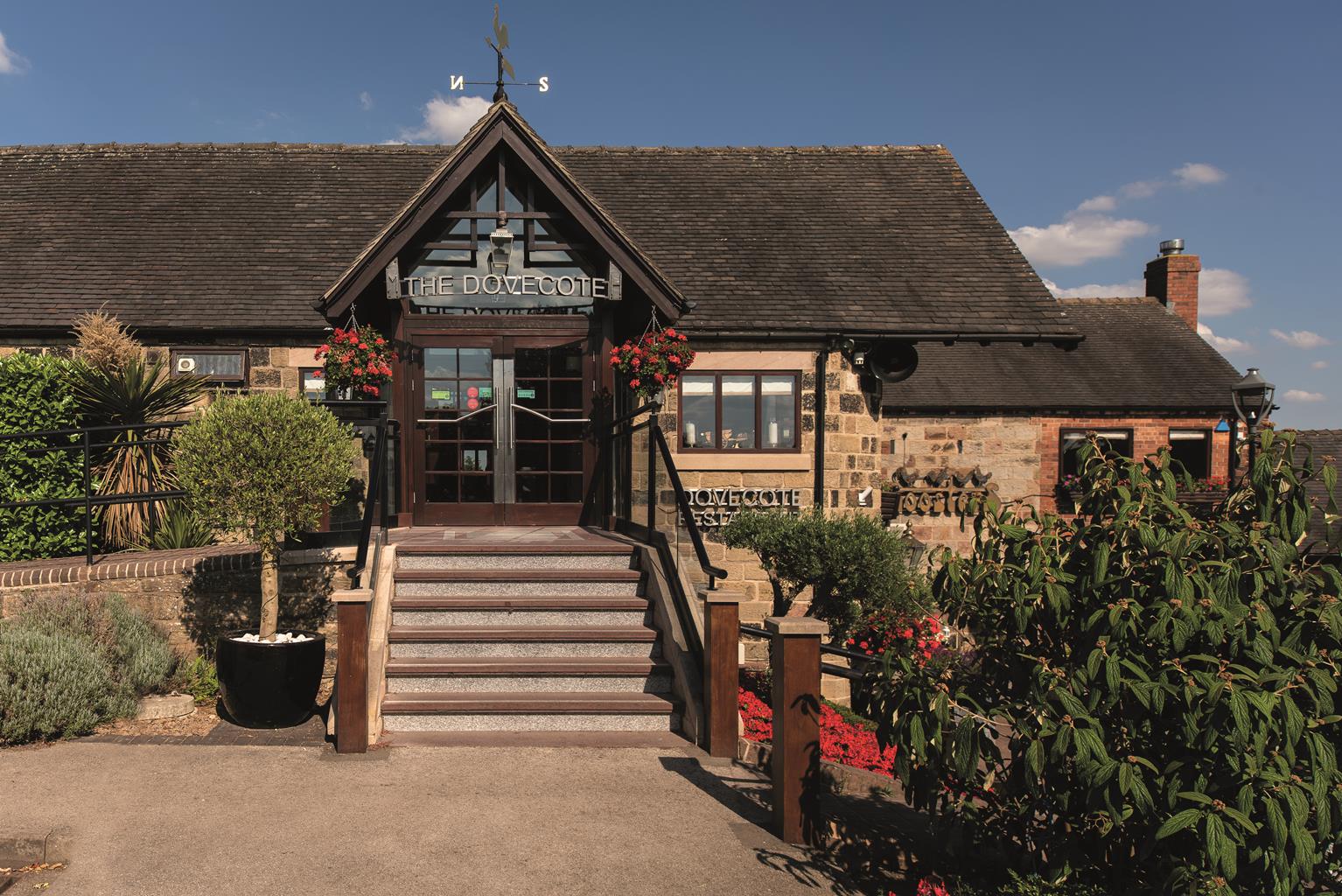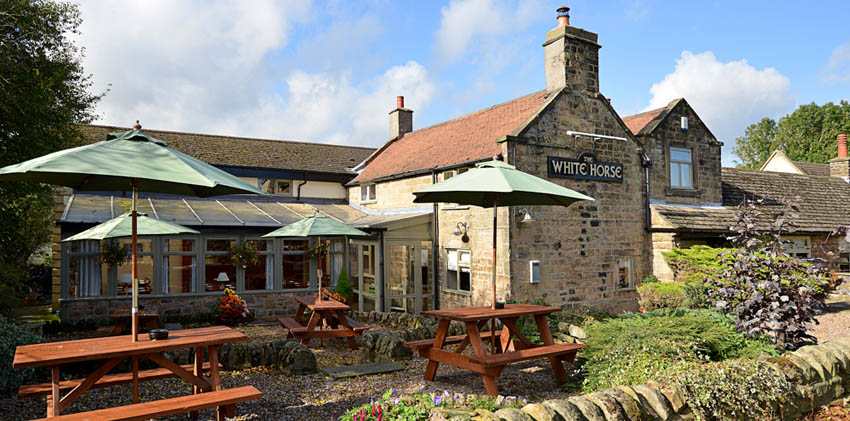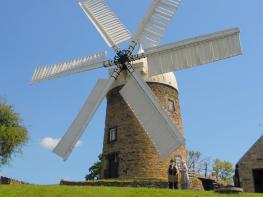Part of the Chatsworth Estates at Shottle, Dannah Farm Country House is an impressive Georgian…
From Ambergate to Crich

Climb an ancient beacon hill for a far reaching view over the countryside
7.5 miles (12.1kms)
About the walk
The first five minutes of the walk are somewhat uneventful and everyday but as soon as you turn the corner and cross over Poyser’s Bridge you’re walking in a different world, separate from the road and the railway. The canal, tangled with irises and pondweed, ambles by slowly through the trees. Watch out for the bright yellow-and-black spotted longhorn beetle feeding on the meadowsweet and the holly blue butterflies in springtime.
On this journey you save the greater part of the canal walking to the end, in order to climb through the woodland of Crich Chase, once part of a hunting forest owned by the 13th-century Norman baron Hubert FitzRalph. After climbing high fields and along a gritstone edge, known as The Tors, you come upon Crich (pronounced so the ‘i’ rhymes with eye). Older readers may get that déjà vu feeling – Crich was the setting for Cardale in Peak Practice, a popular 1990s TV drama featuring a country medical practice, after which the village chippy is still named. Beyond the market cross and over more fields you come to the Crich Tramway Village museum, which is well worth a visit.
The walk continues to its high point on Crich Stand, a limestone crag uplifted within an area of sandstone and gritstone. Capping the Stand is a 60ft (18m) beacon tower, rebuilt in 1922 to commemorate the Sherwood Foresters killed in World War I. On a clear day it is said you can see as far as the Humber Bridge. Often you’ll see kestrels hovering around the cliff edge, searching for their prey. The path descends through more woodland, beneath the shady gritstone cliffs of the old Duke’s Quarries and down to the canal at Whatstandwell.
The canal here has been allowed to silt up and has become a haven for wildlife, including endangered water voles. It’s well known for its many varieties of hoverfly, its azure damselflies and brown china-mark moths. Yellow irises and flowering rushes, which have pink flowers, can be seen at the water’s edge, while dense green pondweed clogs the middle of the canal. That doesn’t seem to impede the moorhens or mallards, though, and by the time you get back to Ambergate you will have seen a wealth of wildlife.
Walk directions
Walk down to the main road from the car park. Go left beneath the bridge and then right along the busy A6. Turn right up Chase Road, and underneath the railway bridge to the Cromford Canal at Poyser’s Bridge. Follow the towpath left to Grattans Bridge.
Bend around left and over the bridge, then almost immediately take a gate on the left by a spring. A waymarked path winds up through the woodland of Crich Chase, steep at first, then almost contouring through occasional small clearings. Join a track, heading left to a field wall corner at the top of the woodland. Continue ahead between the treeline and the field fence. By the end of a crumbling wall, turn right over a stile, then rise up field edges to reach Chadwick Nick Lane.
Turn right along the road. At a fingerpost just beyond the brow of the hill, double back left up steps to a stile. Head north at the edge of successive fields with stiles, following the crest of The Tors ridge. Enter an enclosed path towards the far end, which descends gently to a road, emerging opposite Crich Fire Station.
Pass The Jubilee trees, then along a narrow section of road and down to the Market Place in Crich. Fork left up an unnamed road, then right up Coasthill, climbing ahead to its dead end. Follow a path ahead across a couple of fields, then fork right to join a track by a house and out to the road. Turn right and pass the Crich Tramway Village.
At a sharp right-hand bend, turn left towards the Memorial Tower. Take a footpath avoiding the road then go up the approach road to Crich Stand. Bear right below the monument on a stony footpath which eventually descends and curves left to skirt Cliff Quarry.
Cross the museum’s tram track near its terminus and bear right on a descending woodland path. Towards the bottom, this crosses over a quarry track at a dog-leg junction under power lines. Fork left on to a small campsite’s driveway (Cliff Farm), then keep ahead to emerge on to a road.
Cross diagonally right to a footpath. Descend gently at the left field edge, continuing through scrub and eventually into a long wooded valley. Pass some imposing craggy remnants of the former Duke’s Quarries then cross over a lane. The track opposite leads down through further woodland, forking right to cross Sim’s Bridge over the canal, just north of Whatstandwell. Turn left towards Ambergate and loop round to join the canal towpath.
Now follow a delightful towpath for 2 miles (3.2km) through the shade of tree boughs. At Poyser’s Bridge you meet the outward route and retrace your steps back to the car park.
Additional information
Short section of busy road-side pavement at start/end, woodland and field paths and canal towpath, a couple of narrow road sections with no pavement, some stiles
Woods and pastured hills, quarried edges
Keep on lead - and keep out of the canal to protect water voles and other wildlife.
OS Explorer OL24 Peak District – White Peak Area
Ambergate pay car park by station
Near Sherwood Foresters Monument and in Crich
WALKING IN SAFETY
Read our tips to look after yourself and the environment when following this walk.
Find out more
Also in the area
About the area
Discover Derbyshire
The natural features of this central English county range from the modest heights of the Peak District National Park, where Kinder Scout stands at 2,088 ft (636 m), to the depths of its remarkable underground caverns, floodlit to reveal exquisite Blue John stone. Walkers and cyclists will enjoy the High Peak Trail which extends from the Derwent Valley to the limestone plateau near Buxton, and for many, the spectacular scenery is what draws them to the area.
The county is well endowed with stately homes – most notably Chatsworth, the palatial home of the Duke and Duchess of Devonshire, with its outstanding collections of paintings, statuary and art. Other gems include the well preserved medieval Haddon Hall, the Elizabethan Hardwick Hall, and Kedleston Hall, whose entrance front has been described as the grandest Palladian façade in Britain.
The spa town of Matlock is the county’s administrative centre and other major towns of interest include Derby and the old coal mining town of Chesterfield, with its crooked spire. Around the villages of Derbyshire, look out for the ancient tradition of well dressing, the decorating of springs and wells – the precious sources of life-sustaining water – with pictures formed from flowers.
Nearby stays
Restaurants and Pubs
Nearby experiences
Recommended things to do
Why choose Rated Trips?
Your trusted guide to rated places across the UK
The best coverage
Discover more than 15,000 professionally rated places to stay, eat and visit from across the UK and Ireland.
Quality assured
Choose a place to stay safe in the knowledge that it has been expertly assessed by trained assessors.
Plan your next trip
Search by location or the type of place you're visiting to find your next ideal holiday experience.
Travel inspiration
Read our articles, city guides and recommended things to do for inspiration. We're here to help you explore the UK.














